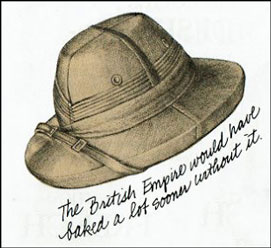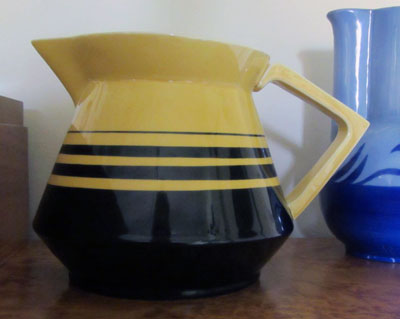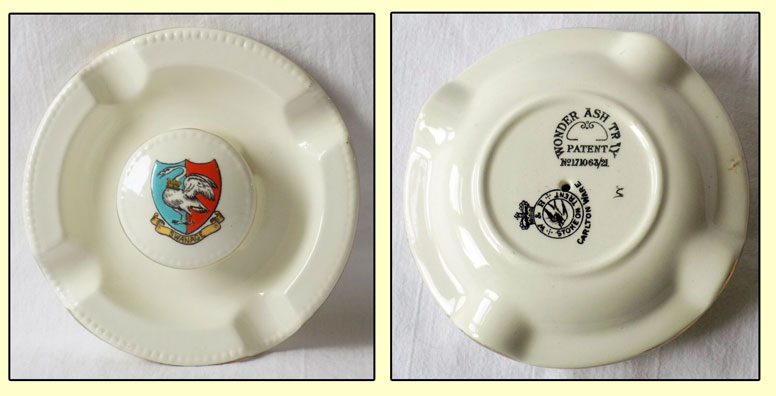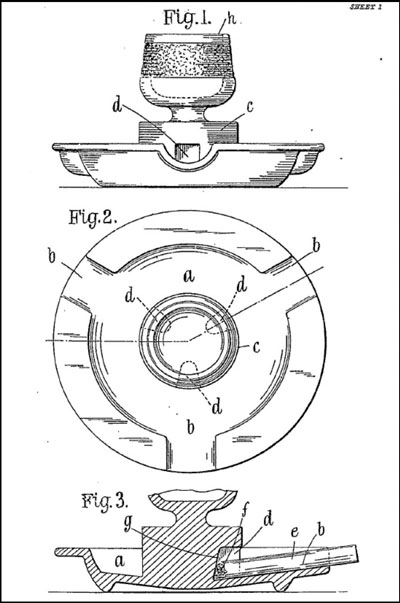
The Carlton Ware

Aside from manufacturers of alcoholic drinks, many other companies commissioned Carlton Ware to make pottery for them, usually as means of advertising. One was Rowntrees, though in this case the chocolate maker's name was not used on the Carlton Ware supplied to them.
Although the York based company was one of the big three confectionary manufacturers on the UK, alongside Cadbury and Fry, it was also a large manufacturer of cocoa powder. Hence the associated Carlton Ware cocoa jugs that I show below.

Below is an advertisment discovered in an Indian publication from the 1930s, presumably aimed at the British working there. Notice the artist's impression of the cocoa jug that is shown and that it is very similar shape to those above.


Since Rowtrees had a big export market, there must be similar advertisements in other newspapers or magazines from the 1930s in other countries.
Presumably, a UK advert would not show the sketch of father wearing a pith helmet running with his children. Presently, a pith helment is not a requirement for our cooler climate.
Did you know that a pith helmet is made from the pith of an Indian swamp plant, the sola? Cork is an alternative material.

How do we know it was made for Rowntrees?
We only know that it was made for Rowntrees because in pattern records the entry for the yellow & black decoration, 3728, tells us that it was for the "Rowntrees jug" S968. Otherwise, we might not have discovered a connection.
The green version with the dark green bands, 3720, is not referred to as a Rowntrees pattern, though possibly is.
The decoration on the right with blue ground and a freehand flower and leaves in a darker blue is not listed in pattern records but perhaps that too was supplied to Rowntrees.
How Rowntrees made these jugs available is unknown. They might have been purchased or given away with vouchers that came with their tins of cocoa. Possibly they were a gift to retailers as part of the "Chocolate wars" with Cadburys that existed in the 1930s.
Registered DesignThe shape of the jug was registered by Carlton Ware in 1934, Rd.No.789535. This meant that Rowntrees could not go to another maker in an attempt to get a cheaper price without infringing the right to use the design. The pottery was probably protecting itself. It must have been bitten in this way before by other customers taking their orders elsewhere because of competitors undercutting.

Unusual shape for Carlton Ware
The source of the shape is likely to be continental. Both the V&A and the British Museum hold an example of a near identical shape made by the pottery of Christian Carstens in Gräfenroda, Germany, renowned for its "Spritzdekor" patterns that were produced with stencils and an airbrush. Both museums estimate the date as c.1930.
The Carstens' jug has a metal lid. Perhaps the Carlton Ware ones did too. How the shape ends up being made at Copeland Street is unknown. Perhaps someone at Rowntrees had bought one in Germany and asked for it to be copied. Possibly, the designer escaped Germany in terrible times and sought work in the Staffordshire Potteries. Time may or may not reveal.

Finally, let's finish with a Carlton Ware flourish by showing another jug shape that has been found with the Rowntrees yellow and black bands decoration.
Thanks must go to Carole Moore for her pictures; The Adguy at Advertisements India; V&A; British Museum.© Copyright Harvey Pettit 2020.
The Carlton Ware

Wonder Indeed!
At fist site, the ash tray appears unremarkable…
Is there some devilish mechanism under the dome that sits at its centre, or does it hide some complex ventilation system to disperse smoke?
What was it meant to do?
As the backstamp used on examples tells us, the design was patented. So who had invented it and what was its function?

Internet searches offered no information. Therefore, only by tracking down the original patent might its secret be revealed.
Patent No.171063/21

The suffix after the patent number tells us that the patent was granted in 1921. This narrowed down my search considerably. After a little detective work, I eventually found a copy of the patent, which included the drawing shown on the right.
The Fig.3 cross section shows a cigarette (e) positioned in the device.
The applicant, perhaps inventor, who applied for the patent in February 1921, was a Jacob Alfred Jacobs of Westcliff-on-Sea in Essex.
The nature of the invention is as follows:-
A suitable dish of china, earthenware, metal
or the like in the centre of which is a raised enclosed platform with apertures round the base to admit the lighted end of a cigarette slip in and touch an interior partition, the absence of a current of air thus causes the cigarette to go out instead of burning to waste.
If the cigarette is so placed that the end does not enter the aperture it continues to burn as in an ordinary ash tray.
The patent allowed for numerous variations, such as the addition of a match holder/striker as seen in the drawing.
So there you have it. The ash tray is designed to extinguish cigarettes simply by placing the burning end into one of the apertures at its centre.
The Wonder Ash Tray Company LtdI also discovered The Wonder Ash Tray Company Ltd , presumably set up by Mr.Jacobs, the applicant, after the patent was granted in November 1921. In March 1929 a notice was placed in The London Gazette to say that the Company Ltd was now dissolved.
I was unable to find any advertising or promotional material for the ash tray but surely there must have been some.
Quite what the link between Carlton Ware and the Company was is unknown. Perhaps Mr. Jacobs commissioned Carlton Ware to make the ash trays for him to market, or Carlton Ware had paid him commission. Or had Carlton Ware bought the patent?

Invariably, the ash tray is found with a heraldic crest on its central dome, as on the example above. However, I have a record of one used to advertise The Holland Varnish Company , Montreal , Canada, so clearly some were used to promote businesses.
These curious ash trays were also exported to Perth in Australia, according to an advertisement in The West Australian for April 1922, which says:
'Just arrived the Wonder Ashtray, the useful novelty, 2 shillings & 6 pence and 3 Shillings & 6 pence.'
Hay Street, PerthThe advertiser and retailer was William Sandover & Co ., Hay Street, Perth. Below is a postcard from c.1905 showing his arcaded store at the centre of the card. I include this for our Australian collectors and also to say that in 1907 this grand store burnt down.
I speculate heavily that if the Wonder Ash Tray had been invented and extinguishing cigarettes before the 1907 fire then Sandover's outstanding building might have survived!

I wonder if any of Mr. Jacobs's relatives have any memorabilia of their ancestor's invention?
That's all for now.
© Harvey Pettit 2020